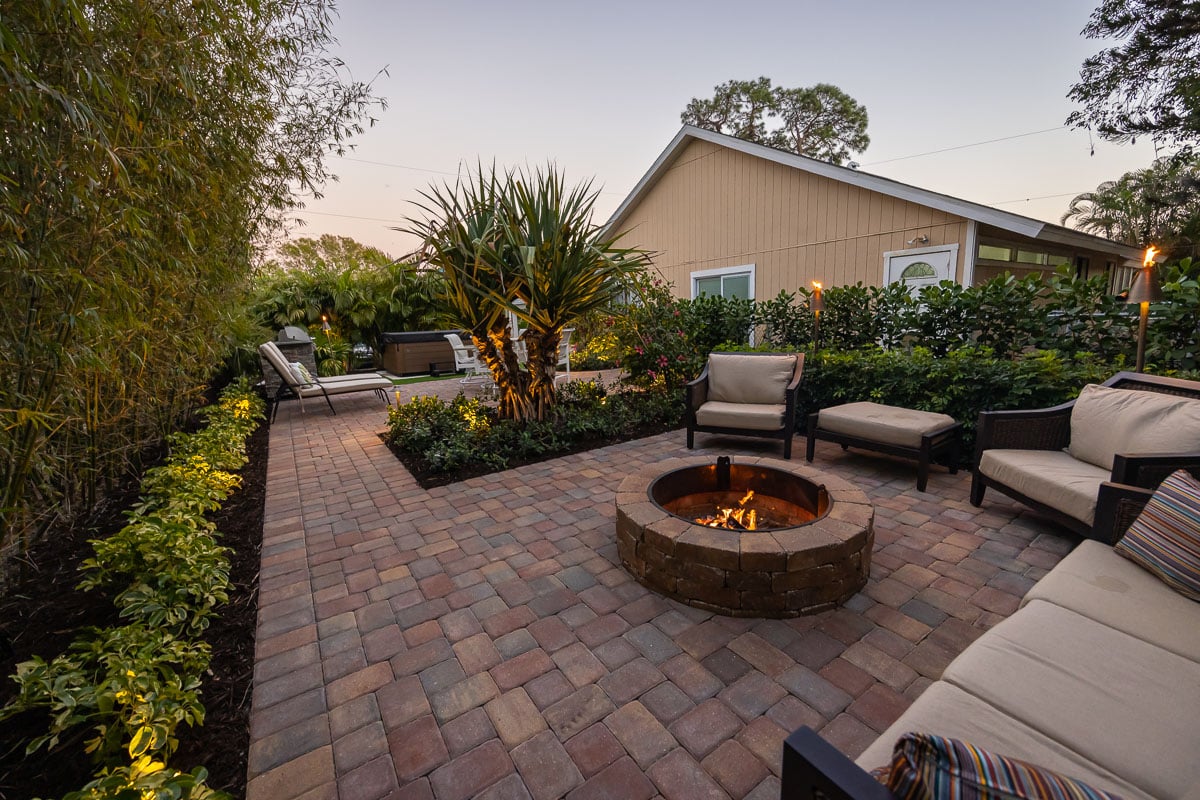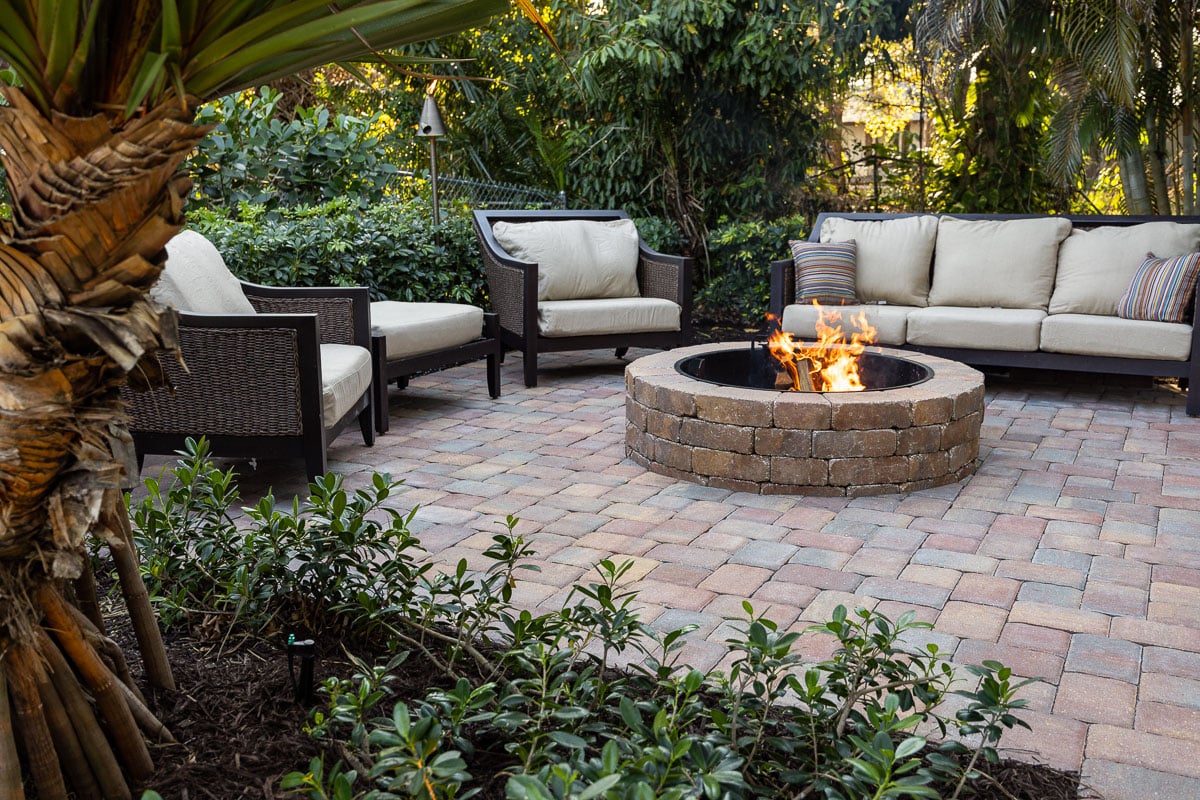


There’s nothing quite like a warm Florida evening, a soft breeze in the air, and the glow of a fire pit bringing friends and family together. But when choosing a fire pit, should you go with gas or wood?
In Florida, where the climate is warm year-round, your fire pit isn’t just for chilly nights—it’s an outdoor feature for ambiance, entertainment, and relaxation. Whether you want a quick and easy flame for poolside lounging or a rustic fire for roasting marshmallows, let’s compare gas vs. wood fire pits and find the perfect fit for your Florida backyard.

Before we get into the gas vs. wood debate, let’s talk about Florida’s unique factors:
Gas Fire Pit: Perfect for Florida homeowners who love quick and easy backyard enjoyment. With the push of a button, you have an instant, controlled flame—no mess, no hassle. If you entertain often or have a lanai, patio, or pool area, a gas fire pit adds ambiance without smoke or cleanup.
Wood Fire Pit: Brings the classic crackling fire experience but requires time and effort. In Florida’s humid climate, storing firewood can be a challenge—damp wood is harder to burn and can attract insects like termites and palmetto bugs.
Florida Verdict: Gas wins for convenience, wood wins for nostalgia. If you love low-maintenance outdoor living, gas is the way to go.

Gas Fire Pit: Higher upfront costs ($1,500–$5,000+), especially if you need to run a gas line. However, natural gas is affordable in Florida, and propane tanks are easy to swap out.
Wood Fire Pit: Lower initial cost ($300–$1,500), but you’ll need to buy and store dry firewood, which can be tricky in Florida’s humid conditions.
Florida Verdict: If you want to spend less upfront, go with wood. If you prefer long-term convenience, gas is worth the investment.
Gas Fire Pit: Minimal upkeep—just wipe it down and check the gas lines. Many Florida homeowners opt for stainless steel gas fire pits to prevent rust from humidity and salt air.
Wood Fire Pit: Requires regular cleanup of ash and soot, which can be a pain in Florida’s rainy season. If left uncovered, wood pits collect water, leading to mold or rust.
Florida Verdict: Gas is better for Florida’s climate—less maintenance and no worry about soggy firewood.
Gas Fire Pit: Provides a steady flame and soft warmth—ideal for mild Florida evenings when you just want ambiance.
Wood Fire Pit: Burns hotter and produces more heat, but in Florida’s warm climate, do you really need that much extra warmth?
Florida Verdict: Gas offers comfortable heat without overheating your backyard. If you live in North Florida, where winters are cooler, wood might be a better choice.
Gas Fire Pit: Safer in residential areas and meets most Florida HOA rules. No flying embers, no unexpected flare-ups. However, always check for gas leaks if you smell anything unusual.
Wood Fire Pit: More restrictions in dry seasons, especially in South Florida where wildfire risk can be a concern. Always check local fire codes and HOA regulations before installing a wood-burning fire pit.
Florida Verdict: Gas fire pits are safer and more HOA-friendly—a big plus for many Florida homeowners.
Ask yourself these Florida-specific questions:
 Both gas and wood fire pits can transform your Florida backyard into a cozy retreat, but the best choice depends on your lifestyle.
Both gas and wood fire pits can transform your Florida backyard into a cozy retreat, but the best choice depends on your lifestyle.
Choose Gas If You Want: Quick flames, low maintenance, HOA compliance, and a fire pit for ambiance by the pool or patio.
Choose Wood If You Want: A traditional fire experience, intense heat, and a lower upfront cost—just be ready for extra upkeep.
Looking to upgrade your backyard with a gas or wood fire pit in Sarasota? Whether you want a sleek, modern gas fire pit for your patio or a traditional wood-burning fire pit for cozy gatherings, we’ve got you covered.
We specialize in fire pit installation for homes in Sarasota, Siesta Key, Longboat Key, and nearby Florida areas. Our team can help you choose the best fire pit for your space, install it professionally, and ensure it lasts for years to come.
Call us today at (941) 231-7027 or visit our Get Started page to schedule your consultation and start enjoying beautiful Florida nights around your new fire pit.